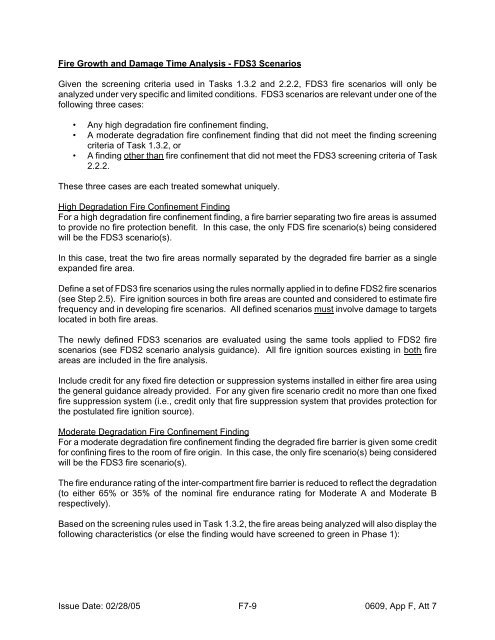IMC 0609, App F, Att 7 - NRC
IMC 0609, App F, Att 7 - NRC
IMC 0609, App F, Att 7 - NRC
Create successful ePaper yourself
Turn your PDF publications into a flip-book with our unique Google optimized e-Paper software.
Fire Growth and Damage Time Analysis - FDS3 Scenarios<br />
Given the screening criteria used in Tasks 1.3.2 and 2.2.2, FDS3 fire scenarios will only be<br />
analyzed under very specific and limited conditions. FDS3 scenarios are relevant under one of the<br />
following three cases:<br />
• Any high degradation fire confinement finding,<br />
• A moderate degradation fire confinement finding that did not meet the finding screening<br />
criteria of Task 1.3.2, or<br />
• A finding other than fire confinement that did not meet the FDS3 screening criteria of Task<br />
2.2.2.<br />
These three cases are each treated somewhat uniquely.<br />
High Degradation Fire Confinement Finding<br />
For a high degradation fire confinement finding, a fire barrier separating two fire areas is assumed<br />
to provide no fire protection benefit. In this case, the only FDS fire scenario(s) being considered<br />
will be the FDS3 scenario(s).<br />
In this case, treat the two fire areas normally separated by the degraded fire barrier as a single<br />
expanded fire area.<br />
Define a set of FDS3 fire scenarios using the rules normally applied in to define FDS2 fire scenarios<br />
(see Step 2.5). Fire ignition sources in both fire areas are counted and considered to estimate fire<br />
frequency and in developing fire scenarios. All defined scenarios must involve damage to targets<br />
located in both fire areas.<br />
The newly defined FDS3 scenarios are evaluated using the same tools applied to FDS2 fire<br />
scenarios (see FDS2 scenario analysis guidance). All fire ignition sources existing in both fire<br />
areas are included in the fire analysis.<br />
Include credit for any fixed fire detection or suppression systems installed in either fire area using<br />
the general guidance already provided. For any given fire scenario credit no more than one fixed<br />
fire suppression system (i.e., credit only that fire suppression system that provides protection for<br />
the postulated fire ignition source).<br />
Moderate Degradation Fire Confinement Finding<br />
For a moderate degradation fire confinement finding the degraded fire barrier is given some credit<br />
for confining fires to the room of fire origin. In this case, the only fire scenario(s) being considered<br />
will be the FDS3 fire scenario(s).<br />
The fire endurance rating of the inter-compartment fire barrier is reduced to reflect the degradation<br />
(to either 65% or 35% of the nominal fire endurance rating for Moderate A and Moderate B<br />
respectively).<br />
Based on the screening rules used in Task 1.3.2, the fire areas being analyzed will also display the<br />
following characteristics (or else the finding would have screened to green in Phase 1):<br />
Issue Date: 02/28/05 F7-9<br />
<strong>0609</strong>, <strong>App</strong> F, <strong>Att</strong> 7
















